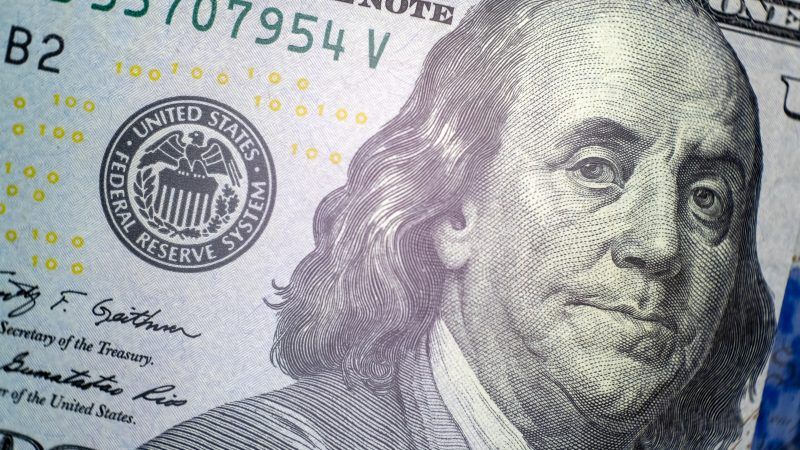America Has Borrowed $1 Trillion Since the Start of Football Season
The federal government is borrowing money at a mind-spinning rate, and you can't blame it on the COVID-19 pandemic anymore.

Here's how fast the federal government is borrowing piles of money: when the national debt hit $33 trillion in mid-September, the current National Football League (NFL) season was already two weeks old.
You don't have to be a fan of sports to know that football season in America isn't particularly long—excluding the playoffs, teams play 17 games over the span of 18 weeks. The final games of the season are scheduled to be played this upcoming weekend, a few days after the national debt officially surpassed a new threshold: $34 trillion, according to an announcement made Wednesday morning by the Treasury Department.
In other words, don't feel bad about how much money you've probably lost on sports betting and fantasy leagues this year. The federal government has run up a $1 trillion tab in less time—and the next trillion-dollar threshold isn't far off.
"Looking ahead, debt will continue to skyrocket as the Treasury expects to borrow nearly $1 trillion more by the end of March," said Michael A. Peterson, CEO of the Peter G. Peterson Foundation, in a statement. "Adding trillion after trillion in debt, year after year, should be a flashing red warning sign to any policymaker who cares about the future of our country."
Indeed, it's astounding how quickly the federal government is piling up new debt. Equally remarkable is how much sooner it has hit some of these thresholds compared to the expected trajectories before the COVID-19 pandemic. As the Associated Press (AP) points out, as of January 2020 the Congressional Budget Office (CBO) projected that the federal government wouldn't be $34 trillion in debt until 2029.
Since then, the debt has grown faster due to the unprecedented levels of fiscal stimulus unleashed during the pandemic and because baseline federal spending has failed to return to pre-pandemic levels. In the fiscal year that ended in September, the federal government spent $6.1 trillion, up from $4.4 trillion in fiscal year 2019 (the last one before the pandemic). Federal revenue has climbed in recent years as well—$4.4 trillion last year, up from $3.5 trillion in 2019—but those increases haven't been large enough to keep up with the surge in new spending.
In that January 2020 CBO report cited by the AP, federal spending was expected to hit $5.3 trillion by 2023. The federal government is now running about $800 billion ahead of that pace—and that doesn't account for any of the one-time emergency COVID-related spending—and so naturally the annual budget deficits are bigger and the national debt is growing at a faster rate.
"Though our level of debt is dangerous for both our economy and for national security, America just cannot stop borrowing," said Maya MacGuineas, president of the Committee for a Responsible Federal Budget, a nonprofit that advocates for lower deficits, in a statement. "This is a moment of consequence and continuing to refuse to pay our own bills will not lead us to where we need to be as a nation."
In some ways, it seemed like 2023 was the start of a political reckoning with the government's addiction to borrowing. In August, Fitch cut the federal government's credit rating, and Moody's warned in November that it might soon do the same. Against that backdrop, Congress navigated a debt ceiling increase that placed some new limits on future discretionary spending—even though so-called mandatory spending on things like Social Security and Medicare are the bigger drivers of the long-term budget problems.
The debt is likely to become an even bigger story in the new year: "The Debt Matters Again," proclaimed The New York Times this week, noting that economists who spent the past decade downplaying concerns about the debt are now getting more worried because of how higher interest rates have made borrowing more expensive.
That's a nasty feedback loop—one that Reason and others have been warning about for years—that means the federal government will have to borrow more money in future years to afford the payments on the money it has already borrowed. The Peterson Foundation estimates that the government spends about $2 billion per day just to service the cost of existing debt.
Oh, and Congress still hasn't passed a budget for the year. The current continuing resolution expires in two stages: one later this month and a second in early February.
Until lawmakers make some serious changes to fiscal policy, expect these announcements to keep coming with greater frequency—at least for a little while. The United States has about 20 years until "no amount of future tax increases or spending cuts could avoid the government defaulting on its debt," economists at the University of Pennsylvania warned in October.
One of the things that makes professional football so compelling is the urgency that comes with each week. With so few games on the schedule, each one is seemingly the most important of the year, and even a single loss early in the season can have a significant impact on a team's long-term aspirations.
Congress would do well to embrace that same sense of urgency when it comes to the country's fiscal status, which is a game no one should want to lose.
Show Comments (69)